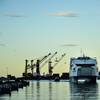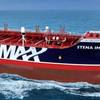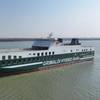Built by Hanjin Heavy Industries for the transportion of liquefied natural gas (LNG) between Oman and Korea, Hanjin Muscat is a 918 ft. (280 m), 68,524-dwt ship using Gaz Tranport's No. 96-2 membrane cargo containment system. The vessel was built with only four cargo tanks, contained within a complete double side/bottom/bulkhead/deck trunk structure, with top and bottom wing tanks. The side and bottom spaces from integral port and starboard water ballast tanks, divided by the duct keel. This double-hull structure not only protects the tanks from external damage, but insulates the outer hull against critical steelwork fractures cased by the low temperatures (-163 degrees C and atmospheric pressure) at which cargo is transported.
Tank insulation is formed by primary and secondary membranes of 0.7 mm Invar (36 percent nickel steel) sheets, in conjunction with expanded perlite beads contained in plywood boxes attached to the inner hull by stud bolts. This combination is able to sustain the liquid pressure, also static and dynamic loads, and to limit the daily boil-off rated to 0.15 percent of cargo volume. Within each tank, the filling line and two Ebara 1,700 cu. m./hr. electric submersible pumps are arranged on a tripod mast.
These pumps are used for unloading purposes, loading being carried out by shore pumps, with vapor produced in the operation returned to shore by the ship's two 32,000 cu. m./hr. compressors. Other equipment includes a 26,000 kg/hr. main vaporizer, and 7,600 kg/hr. forcing vaporizer, 13,800 N cu. m./hr. inert-gas generator, two 140 N cu. m./hr. nitrogen generators and two 1,250 cu. m./hr. vacuum pumps. Four 50 cu. m./hr. stripping/spray pumps, 550 cu. m./hr. emergency cargo pump, and two sets of 20,000 kg/hr. boil off/warm-up heaters are also fitted.
Two crew members can operate and monitor the entire ship from a centralized administration and control center on accommodation deck D, using two separate Yamatake-Honeywell TDC 3000 Basic automation systems. These serve cargo/ballast operations and machinery/electric generation, respectively, with Whessoe tank level gauges, a Foxboro custody transfer systems, and Mitsubishi total boil-off gas control system. Mitsubishi also supplied a loading calculator to assist cargo operations, also an automatic combustion control, burner management and main turbine controls. Other equipment includes an AMCO turbo feed pump control system and Kvaerner ship performance monitors for the machinery installation.
A Mitsubishi MS 40-2 cross-compound steam turbine developing 38,900 shp drives a fixed propeller through a double-reduction gearbox to give a service speed of 20.3 knots, with steam generated from two vertical, two-drum watertube boilers, burning oil or boil-off gas, or a combination of both. Two 3,450 kW turbo alternators and a similar sized diesel-alternator set satisfy electrical requirements. A water scoop system is provided for cooling the main condensor. A Mitsubishi total navigation system is integrated with three radars, echosounder, a Doppler sonar and docking system supplied by Atlas Elektronik, with additional aids including a Tokimec chart plotter and two GPS navigators.
Subscribe for
Maritime Reporter E-News
Maritime Reporter E-News is the maritime industry's largest circulation and most authoritative ENews Service, delivered to your Email five times per week











